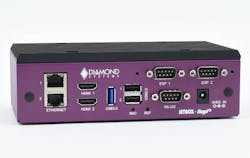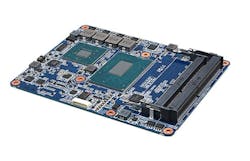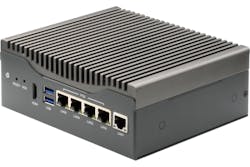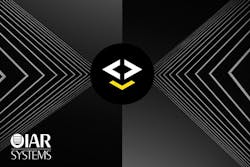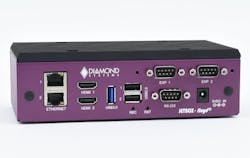Embedded systems were introduced in the 1960s and have evolved from the MOS integrated circuits into multi-core powerhouses capable of processing complex AI applications. Embedded technology can be found in nearly every industry, including robotics, medical, and autonomous vehicles, and will continue to grow exponentially in the coming years. In this roundup, we will take a look at several of the latest advancements in embedded systems and their potential applications.
New System on Module (SoM) takes Advantage of Intel for Edge Computing
Avalue has released a new SoM (System on Module) designed for edge computing, high-resolution imaging, HMIs, and even gaming. The company's ESM-CFH PICMG COM R3.0 Type 6 module can take advantage of Intel's 8th and 9th generation of Xeon and Core processors and offers up to 3X DDR4 2400 SO-DIMM modules. I/O includes 4X USB 3.2 Gen 2 ports, 8X USB 2.0 ports, 1X Gen3 PEGx16, 8X PCIex1, and 4X SATAIII. The ESM-CFH also supports dual-channel 18/24-bit LVDS, VGA, and DP/HDMI/DVI. The SoM is also capable of driving three 4K displays.
Mobile NVR can be Tailored for Industrial and Vehicle Applications
AAEON has announced its VPC-3350S NVR system's availability, which offers a modular design that's flexible, customizable, and user-friendly. The NVR is outfitted with Intel's Atom x5 E3940 processor but can be equipped with a Pentium N4200, Celeron N3350 or Atom x7 E3950 if needed. The VPC-3350S is also equipped with 4X PoE ports, up to 4X PCIe slots, and features a fanless enclosure that can handle operating temperatures that range from -20°C to 70°C.
The NVR comes in two configurations, including an Industrial unit and an In-Vehicle system. The Industrial version features a compact design with plentiful I/Os, making it easy to deploy as a machine controller or in machine-vision applications. The In-Vehicle version features the same configuration as the Industrial unit but adds a GPS, G-sensor, and CAN Bus.
New Workbench for Arm Provides Integration with Amazon Web Services
IAR Systems has launched a new edition of IAR Embedded Workbench for Arm that provides integration with Amazon Web Services (AWS), allowing developers to log in to an AWS account from within the C/C++ development toolchain IDE. While debugging, users can access the TCP/IP interface, see MQTT packages' status, and inspect the device shadow for complete control from the device to the cloud. The cloud communication with AWS IoT Core can also be inspected and controlled by subscribing to AWS topics and publishing commands. The toolchain also supports the Internet of Things (IoT) Realtime OS and Amazon FreeRTOS. Amazon's FreeRTOS includes software libraries that make it easy to securely connect devices locally to AWS Greengrass or directly to the cloud and update them remotely.
World's Densest FPGA Designed with Millions of LEs (Logic Elements)
Intel's Stratix 10 GX 10M FPGA was created with 10.2-million Logic Elements (LEs), making it the world's densest FPGA chip. To achieve that number, Intel utilized EMIB (Embedded Multi-die Interconnect Bridge) technology to stitch a pair of high-density Stratix 10 GX FPGA core fabric die (5.1 million LEs per die) along with their respective I/O tiles. The EMIB technology logically and electrically bonds two FPGA fabric die together, using tens of thousands of connections to link the two FPGA fabric die via multiple EMIB die, resulting in a high-bandwidth connection between the two monolithic FPGA fabric die. That technology also allows engineers to build almost any device incorporated with different die, such as ASICs, eASICs, I/O tiles, 3D stacked memory tiles and more.
Jetson gets an Enclosure Kit
Diamond Systems has launched its JETBOX-nano enclosure for Nvidia's Jetson Nano Development Kit. The all-steel enclosure measures just 125mm x 95mm x 34mm, and features a two-piece design, making it easy to assemble. Standard ports are exposed on one side of the enclosure, while the left offers access to the serial port and camera flex cable port. The right side features a GPIO port and optional connector, while the rear offers a programming button for software updates. The JETBOX-nano enclosure comes in two configurations, including a basic model and the other with an included GPIO connector on the right side.
About the Author
Cabe Atwell
Technology Editor, Electronic Design
Cabe is a Technology Editor for Electronic Design.
Engineer, Machinist, Maker, Writer. A graduate Electrical Engineer actively plying his expertise in the industry and at his company, Gunhead. When not designing/building, he creates a steady torrent of projects and content in the media world. Many of his projects and articles are online at element14 & SolidSmack, industry-focused work at EETimes & EDN, and offbeat articles at Make Magazine. Currently, you can find him hosting webinars and contributing to Electronic Design and Machine Design.
Cabe is an electrical engineer, design consultant and author with 25 years’ experience. His most recent book is “Essential 555 IC: Design, Configure, and Create Clever Circuits”
Cabe writes the Engineering on Friday blog on Electronic Design.
